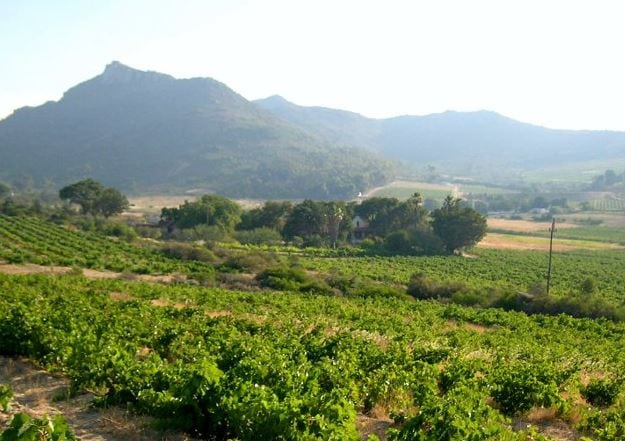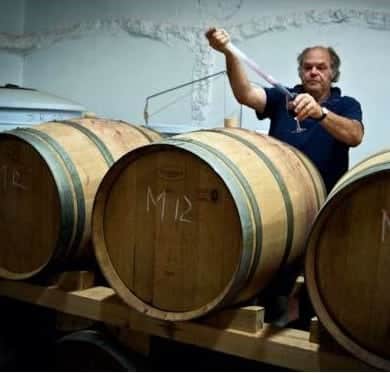Tim James: On Dragonridge
By Christian Eedes, 28 May 2018
Johan and Diana Simons’s Fynbos Estate is in one of the sprawling Paardeberg’s many kloofs – across a few high ridges from more lushly vineyarded and better-known parts. Much of its 300-plus hectares is a nature reserve, and there are visitor cottages and facilities for functions, but all are modest, not imposing on what is undoubtedly one of the loveliest parts of the southern Swartland. There are also some olive groves, however, and 13 hectares of low-yielding bushvines from which Johan makes his wine in a small cellar dating back nearly 200 years.
These go under the Dragonridge brand – named for one of the peaks up which the nature reserve runs. I must have looked a bit doubtful when Johan pointed out the ridge to me, for he assured me that on a starlit Swartland evening, with a good few glasses of Swartland wine well absorbed and making for magic, one can clearly discern the shape of a sleeping dragon. Sounds reasonable to me.
Dragonridge Wines are not among the best known of the Swartland Independent Producers, for reasons including the breadth of the range and the small quantities, and a lack of energetic marketing – Diana and Johan are clearly despondent about the apparent need for social media involvement and the like; and as someone of approximately their age and background, it’s something I sympathise with. It’s hard when your heartfelt efforts are directed at being in harmony with nature, as theirs are, to be enthusiastic about selling yourself on Facebook.
Natural is what the wines emphatically are. “Natural” is a notoriously difficult category to define, and a contested one, but there are very few wine ranges in South Africa that meet the more rigorous standards, which would include hands-off, additive-free winemaking (not uncommon these days, especially in the Swartland) but also organic viticulture (that’s the really tricky bit). As to truly minimal sulphur content, that’s even rarer (and the most contested of the requirements). Dragonridge wines, however, meet all of those standards. They also, incidentally, take to an extreme the requirements for estate wines: Johan, who not only doesn’t enjoy marketing but thinks that truth should simply be allowed, is disappointed that the authorities won’t allow him to claim on his labels that on average for his wines there’s no more than 500 meters from vine to bottle.
So: a small, agricultural effort, from a producer determined to work with nature as much as possible and minimise the human footprint (Johan has recently returned to working only with cork and wax closures as he feels these to be more in accord with such principles), expressing the farm’s unique conditions. Unsurprisingly, the wines are unpretentious and honest, fresh and lively, often idiosyncratic. The range, as I said, is unwieldily large, occasionally unpredictable and adventurous – a good méthode ancestrale bubbly, for example, fits in well with the context, but who’d have expected a rather promising MCC from chardonnay to be on the way?
But Johan doesn’t seem offended or in disagreement when I suggested that he could be called a bit eccentric. Nor did Diana, who added: “He doesn’t care that much what other people think….” I’d guess that most other people would enjoy most of his wines, though – a forthcoming Pinotage 2017, for example, that’s lightly fruity and perfumed, easy-going and delicious, with modest alcohol (like most of these wines) and a hint of pinotage bitterness only adding interest. The best of the reds is probably the Aquila, a balanced, fresh and vivacious blend of sangiovese and cab. (The names of many wines, incidentally, derive from the heavens – stars and constellations, I believe.) But the one that I couldn’t resist buying a few bottles of was the Cygnus 2015, a gorgeously golden, delicious skin-contact, old-wood-matured chenin. A steal at R120.
Dragonridge wines are not easy to find, but if you’re within striking distance, you could do much worse than make a visit, which would be tonic for the soul as well as the tastebuds. Directions and plenty of information on the website.
- Tim James is one of South Africa’s leading wine commentators, contributing to various local and international wine publications. He is a taster (and associate editor) for Platter’s. His book Wines of South Africa – Tradition and Revolution appeared in 2013.









Comments
0 comment(s)
Please read our Comments Policy here.